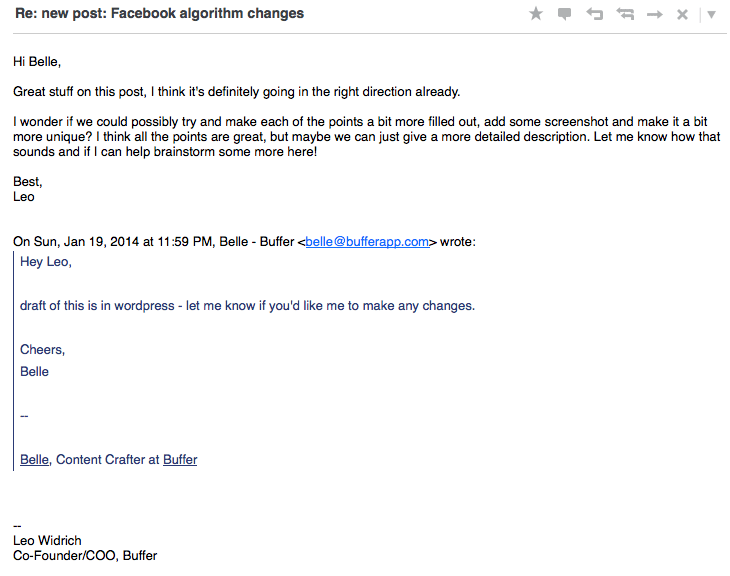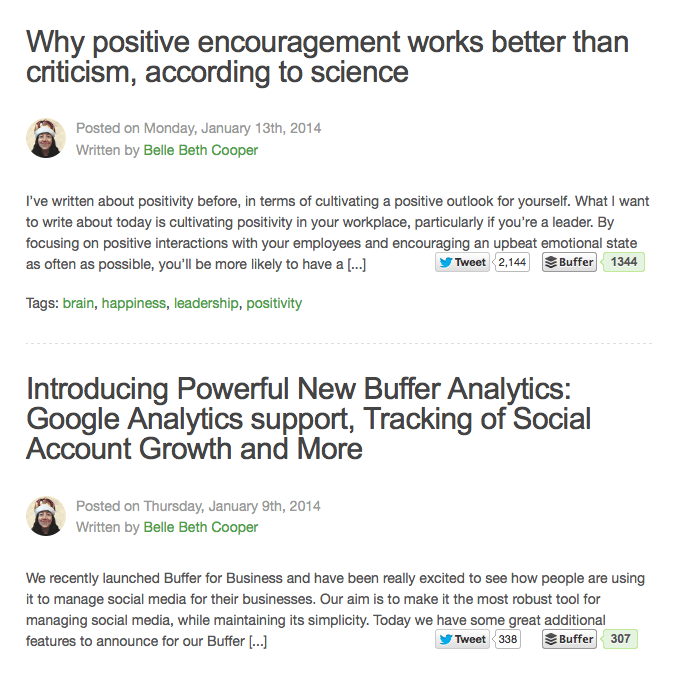6 Ways I’ve Improved My Writing In the Past 6 Months You Can Try Today

In the past six months that I’ve been a Content Crafter at Buffer, I’ve been writing a lot. I’ve also been trying to write regularly on my own blog and for my startup, Exist. That’s a lot of writing.
During this time, I’ve also been experimenting with small changes in my workflow, my writing process and the types of content I produce. The result has been an improvement in my writing and a better understanding of how I work best. Hopefully you’ll find some of these things helpful in improving your own writing.
1. Exposing it to different people for feedback
Feedback is hugely important for my writing. If I don’t spend long on a piece, I often overlook small typos or grammatical issues. I don’t craft my words quite as carefully as I could, and I tend to repeat myself a bit. Having someone read over my writing can highlight these issues and help me to clean up my work.
On the other hand, if I spend a long time on a piece, it can be just as bad. It’s easy to become lost in a piece after a while, and have trouble stepping back and seeing it objectively. It’s also hard to forget all of the extra context I have in my head by that point, and read it as a reader, who has little or no context about the topic.
Again, having someone else read my work really helps at this point. If nothing else, it gives me a break to refresh my mind before I come back for more editing. Usually, though, I find my work improves from other people’s suggestions.

While Leo is usually the person who reads through my blog posts for Buffer, occasionally we’ll have a discussion in our Content Crafters room in HipChat and more of the team will jump in.

It’s surprisingly helpful to get ideas and feedback from multiple points of view.
2. Experimenting with new formats and structures
We have a pretty good idea of what works best for us on the Buffer blog, but it’s always interesting to experiment with new content types as well.
Here’s a list of the different types of formats I’ve experimented with over the past few months:
- listicles,
- personal stories,
- opinion pieces,
- how-to guides,
- feature announcements,
- link roundups,
- posts about products and apps I like,
- posts about books I’ve read
- interview-based posts.

The more kinds of content I try creating, the more I find that certain aspects apply to multiple formats (for instance, images usually make a post more interesting, regardless of the format). I also have to work harder when I write a new kind of post, since it doesn’t come to me as easily.
Something I’m keen to try this year is experimenting with long-form content and perhaps even an eBook or downloadable PDF. New formats are exciting and scary, and definitely worth doing if you want to stretch your writing muscle.
3. Changing my workflow with new methods
As well as new formats or types of content, I’ve experimented a lot with my writing process in the past six months. I wanted to optimize for efficiency, but I didn’t want my work to drop in quality. Experimenting is really helpful in determining what works and what doesn’t. In my case, I’ve tried different methods, environments and schedules in my quest for a workflow that suits me.
I’m now at a point where I can write 3-4 posts for Buffer each week, 1-2 for Exist, and an extra one for my personal blog each week if I’m lucky.
One thing I experimented with a lot is the process of brainstorming, outlining and drafting a post. The editing process is usually more straight-forward, and I’m sure many of you would agree that getting those first few words on paper (or screen) is one of the hardest parts of writing.
Depending on the type of post I’m writing and how research-heavy it is, I may go straight to screen with my notes and outline the post. If I’m using lots of quotes—like in this post—I’ll copy-and-paste a lot of material right into my text editor and work from that.
For posts that rely on my own words more, I like to make notes on paper first, to get my head around the topic. I find this useful for getting an overview of the post as a whole and working out the structure I’m going to start with, too.
I love what Austin Kleon says about using paper to sketch out ideas first in his book, Steal Like An Artist:
The computer brings out the uptight perfectionist in us—we start editing ideas before we have them.
Another thing I’ve been doing more is using books for researching topics, rather than blog posts (or as well as blog posts). I like that I can take a book and a pen and do my research in an armchair. It gives me a physical and mental break from sitting at my computer, being connected to the world.
I also find this is a more efficient way for me to take in lots of information about a topic and process it, so the resulting post is higher quality than if I’d tried to take research straight from a blog post and use it before I fully understood it.
4. More practice, less theory
I think everyone working in a creative field struggles against the inclination not to exercise their creative muscles. It’s so much easier to keep researching or reading or tweeting and not get around to putting words down.
For me, I find reading and researching a post are the most nefarious distractions. Because they are important to my work, it’s really difficult to protect myself against my own tendency to do these far longer than is necessary. I read a short essay recently by Fiery Cushman that explained the way people cheat without realizing it, and I’m sure procrastination often works the same way for me:
research shows that people tend to cheat only as much as they can without realizing theyre cheating [Mazar, Amir & Ariely, 2008, Jour. Marketing Res.]. This is a remarkable phenomenon: Part of you is deciding how much to cheat, calibrated at just the level that keeps another part of you from realizing it.
When I do notice that I’m dragging my feet and should have started drafting a post already, I like to remember this quote from David McCullough:
There’s an awful temptation to just keep on researching. There comes a point where you just have to stop, and start writing.
The other way I’m actively trying to curb my own tendency to waste time is to limit what I read. I’ve stopped subscribing to any RSS feeds and I’m much more careful about choosing articles and blog posts to read online. These are the places I get lost most often in content that doesn’t offer me anything new or useful for my work so posts about writing better, productivity and ticking off to do lists are all but banned from my reading list now.
5. Reading (and doing) more widely
While I am actively trying to stop myself from wasting time on content that’s not useful to me, this often comes down to articles that say the same things I’ve read a million times before. On the other hand, I’m trying to be open to reading more widely—more fiction, more varying nonfiction topics, more research papers—to help me add more knowledge to my reportoire.
The more widely read I am, the more chances I have to generate new, creative ideas or come up with interesting angles for each topic I write about.
Widely-ranging experiences are just as important as being widely read, I think. From my experience, the more things I do, the more ideas I have and the better my work is. Though I haven’t been great at this lately, I try to remember that doing new things will give me more to draw on in my work later.
6. Paying attention and taking notes
This point doesn’t really fit in this post, since I’ve actually done a lot less of this in the past six months. I’ve resolved to put more effort into this practice going forward, though, so I’m going to include it anyway, in case it’s useful to you.

Taking copious notes has been remarkably useful to me in the past. I mentioned in the last point that adding to my knowledge gives me more to draw on in my work. Unfortunately, I’m not great at remembering everything I read. Not well enough to find it again, at least. This is where notes come in handy.
Whether I have a notebook handy or I use an app to capture something digitally, keeping track of quotes, books I’ve read, phrases and words I like, interesting concepts and ideas I have is worth the effort.

What have you done to improve your writing recently? Let us know in the comments.
If you liked this post, you might like 5 ways to get through writer’s block or content marketing fatigue and 6 Of The Best Pieces of Advice From Successful Writers
P.S. Recently we launched brand new Buffer for Business, with Google Analytics support, fan and follower growth options and more. Check it out and see if it can help your social media efforts.
Photocredit: mbgrigby
Try Buffer for free
140,000+ small businesses like yours use Buffer to build their brand on social media every month
Get started nowRelated Articles

With the newsletters on this list, you'll be able to stay on top of all developments in social media and learn from amazing experts

If you always feel like you’re chasing the tail-end of audio trends on the app, you’ve come to the right place. In this article, I’ll guide you through all the methods you can use to find the most popular music and sounds on Instagram before they drop off the charts.

I spoke to leading B2B content marketers (an in-house content director, agency owners, top freelancers, and thought leaders) to find out what they think B2B brands can do to create good content in 2024.